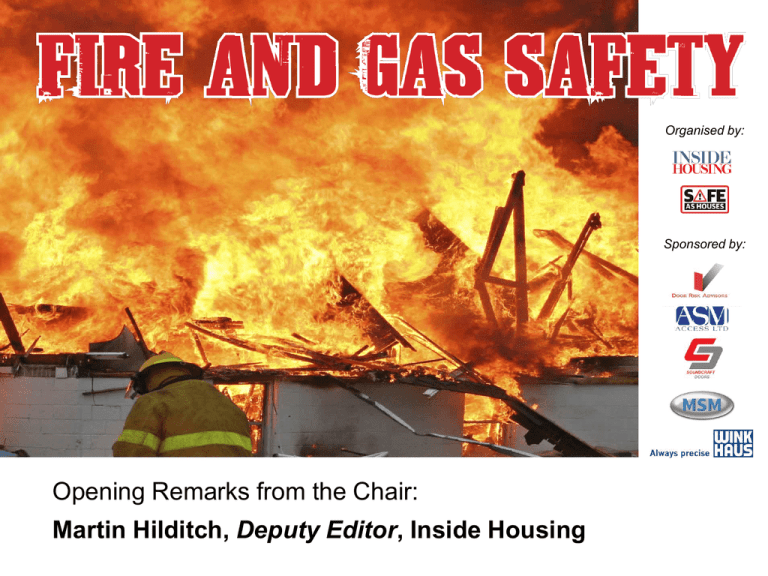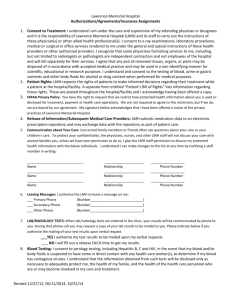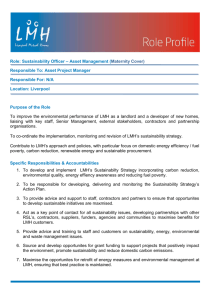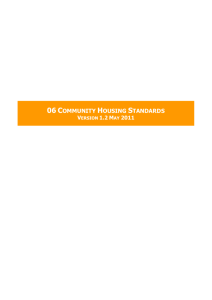presentation
advertisement

Organised by: Sponsored by: Opening Remarks from the Chair: Martin Hilditch, Deputy Editor, Inside Housing Organised by: Sponsored by: Nick Coombe, Head of Fire Safety, London Fire Brigade Fire Safety Order & Housing Inside Housing 29th November 2011 FSO & Residential Premises • Responsible Person or Person in Control • Competent Person • Relevant Person FSO & Residential Premises • Fire Risk Assessment • People especially at risk • Significant findings • Fire Safety Arrangements FSO & Residential Premises • Portfolio Risk Assessment • Prioritise & Plan • Procurement • Petty cash ? FSO & Residential Premises • Enforcement • Reasonable • Proportional • Post Fire FSO & Residential Premises What if it goes wrong? FSO & Residential Premises • Douglas & Gordon • John O’Rourke • Michael Arthur Billings • Mr Parlak Organised by: Sponsored by: Nick Cross, Head of Housing Services, Southampton City Council Fire and Gas Safety Webinar Learning from our experience Nick Cross, Head of Housing Services, Southampton City Council Fire safety in sharp focus • • • • • Fire on the 9th floor of a Tower Block Fire started and was contained in one flat Over 40 families were evacuated in the middle of the night Huge practical operation in managing the scene and the aftermath Sadly 2 firefighters lost their lives The morning after! • • • • • One flat completely gutted Significant water damage to two ‘stacks’ of flats Significant smoke damage on 3 floors 40 plus families in just the clothes they had on Police, Fire and HSE investigations underway The reality of what happened • • • • • A fire started in a single flat and took over 2 hours to extinguish – but the fire was contained within the flat Being a ‘scissor’ block the impact of the smoke damage spread over 3 floors The block had an ‘agreed’ Fire Risk Assessment that had only been carried out the month previously No residents were injured Most occupants of the 150 flats were able to remain in their flats Shared lessons with the Fire Service • • • • Risk Assessments on Tower Blocks are done in partnership with the Fire Service – but are you sure you are working with the right people? Fire Training exercises using different types of Tower Blocks are excellent for local Fire crews – but what about those ‘outside’ crews who attend major incidents? Have information readily accessible for Fire Crews and make sure it is easy to find and interpret Fire safety campaigns and messages need regularly repeating Points to consider as a landlord • • • • • Do you have a regular programme of inspection and certification? Is it sub-contracted? Do your contractors carry out fire stopping works when they make changes to communal areas? Is your signage clear and up to date? Do your residents know what to do in the case of a fire? When did you last remind them? Do you know what residents have any specific vulnerabilities that you need to take into account in case of fire? Specific improvements carried out • • • • • • Emergency lighting is now checked every month and not quarterly Windows in communal corridors are now opened by a master key system Fire retardant paint has been reapplied in corridors All flat front doors have been checked to make sure they are fire rated – including leaseholders! Signage has been improved and updated Wardens check communal fire doors daily Tenancy Visits • • • • • • • As a landlord we cannot tell a tenant how to live – but we have a responsibility to support them if their ‘lifestyle’ might impact on others! Internal alterations can breach fire precautions Hoarding and cluttered properties present a risk Padlocks on fire exits from individual flats Safeguarding and other social ‘concerns’ shared Who is living in a flat? Language and cultural issues In summary • • • • • Make sure you are working in partnership with your local Fire Service Ensure you have an up to date programme of inspections and assessments and you know who does what and when Most fire precautions are simple and not expensive Know your vulnerable tenants and share any issues or concerns with others Regularly remind tenants of what they need to do in case of a fire Organised by: Sponsored by: Michael Vickers, Senior Investment Manager, Liverpool Mutual Homes Gas Safety Ensuring LGSR’s are up to date is key to achieving high levels of gas safety Well publicised programmes will assist 1st time access Use of internet, customer newsletters, block notice boards, text messages, local press High profile community notices, and the use of local TARAS to assist with access Gas Safety Incentives and deterrents can help achieve 1st time access LMH puts all customers who allow 1st time access into a £100 prize draw, this has helped achieve over 78% 1st time access Use of service interrupter programmers which incorporates a message on screen and an audible alarm 14 days prior to service anniversary which changes to an hourly interruption of the gas supply on the anniversary of the service date Use of posters to cover door locks on persistent no access properties LMH has achieved 100% LGSR’s for the last 2 years and are on target to achieve 100% by Christmas for 2011-12 Gas Safety Ensure that access procedures are robustly followed Monitor the process to ensure that at risk properties are at correct stages of your process The reduction of open flued appliances will help reduce the risks LMH remove open flued appliances wherever possible Install Carbon Monoxide alarms If an open flued appliance is still installed LMH will fit a hard wired CO2 detector which is also inspected as part of the annual service Fire Safety Fire prevention is key Develop a Fire risk management strategy Important to identify and manage your risks through robust fire risk assessments Work closely with your local fire authority Ensure robust management of communal areas to reduce fire risks Control fire loading in communal areas Invest in training to enable the workforce to identify and deal with risks Fire Safety LMH are upgrading all communal areas within walk up flats Replacing front doors and frames to all of our flats Upgraded all bin store and communal cupboard doors to FD30 incorporating intumescent smoke seals Inspecting loft compartmentation and installing replacement fire curtains as necessary ensure that loft hatches are fitted with a fire resistant product Ensure all breaks through floors and ceilings are correctly sleeved and fire sealed Replaced vinyl floor tiles with ceramics in communal areas Safe egress by ensuring that emergency lighting is up to standard and maintained Fire Safety Communal area improvements LMH has 630 walk up blocks with communal areas We have been upgrading these since 2009 To date 80% have been completed All due for completion during next 12 months Before Fire Safety Communal area improvements LMH has 630 walk up blocks with communal areas We have been upgrading these since 2009 To date 80% have been completed All due for completion during next 12 months After Fire Safety LMH has worked closely with Merseyside fire authority particularly within our sheltered accommodation Addressed issues identified during fire risk assessments Trained scheme managers to be aware of fire risk management Developing management plans and Personal Emergency Egress Plans (PEEP) to sheltered schemes Incorporate fire risk management into cyclical activities Hard wired smoke detectors to all of our homes, which are cleaned and checked during the annual gas safety inspection Regular block inspections Organised by: Sponsored by: Graham Fieldhouse, H&S and specialist in fire safety in social housing Graham Fieldhouse Fire safety Why Compartmentation Matters Protecting the means of escape Article 14 • Sister block to Lakanal House after the fire • Source: London Evening Standard Kick the Wedge Survey Fireco Ltd . Jan 2007 • Kick the Wedge Survey Fireco Ltd . Jan 2007 • Survey 100 Accredited Fire Risk Assessors / Fire Safety Officers • Inspections where: – fire escapes obstructed 80% – Fire doors wedged open 65% – Door closers removed or disengaged 80% My own observations show this is still happening When a fire door is no protection • Doors & Frames do they meet British Standards • Intumescent Seals have they been painted over? Is that a problem? What if it is smoke seals • Ironmongery are they a tested product to BS • Glazing Detail can you prove it is fire rated? Are all beadings and seals free from damage • Fire Rated Air Transfer Grills (are they connected to the alarm) • Gaps do they meet the correct British standards for fire and if required smoke 3mm We should be OK with a new build ! • We might assume everything should be OK with new built properties, is it? – If fire doors not installed to the requirements set out in the certification they will not be certified – Fire stopping – not real fire stopping or protected walls failing to be sealed to the roof Is this a one off? Picture thanks to Niall Rowan ASFP Draft Guidance Compliant over Certified • What if it just looks ok…. The responsibility is with you if it fails to do its job Source ASFP Draft Guidance Thanks to Niall Rowanof ASFP Working with brigades enforcement team to get it right or should we bury our head in the sand and hope nobody dies • Setting our priorities, agreeing a timeframe protect life, property, and reputation Organised by: Sponsored by: Q&A Organised by: Sponsored by: Closing Remarks from the Chair: Martin Hilditch, Deputy Editor, Inside Housing Organised by: Sponsored by: Thank You - The Webinar is Now Closed








